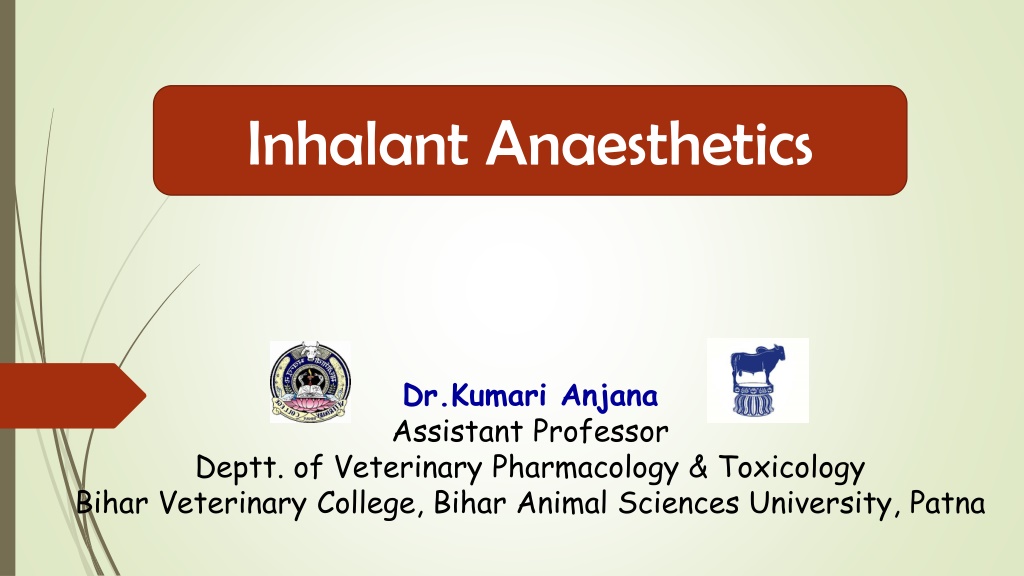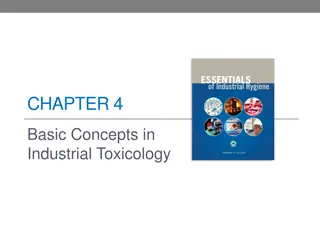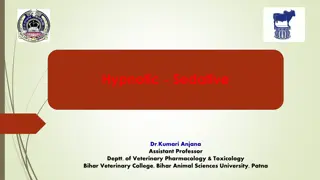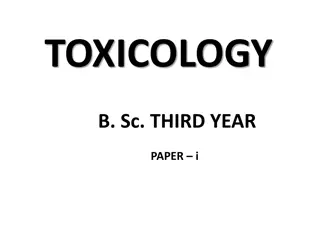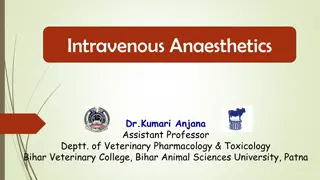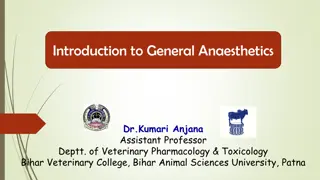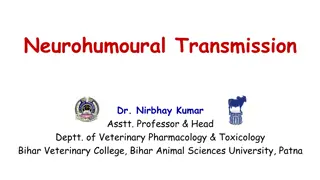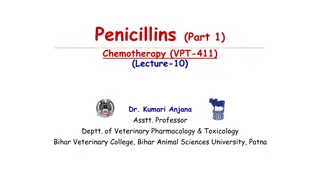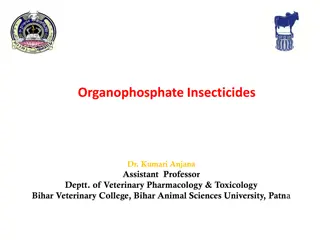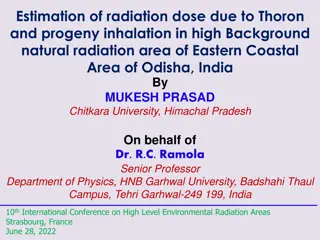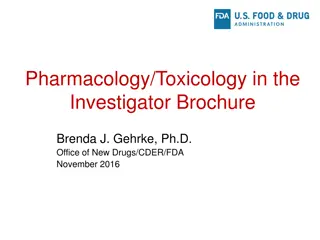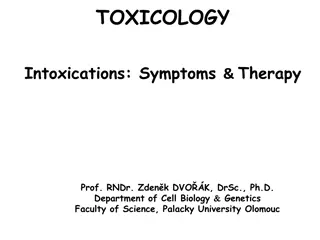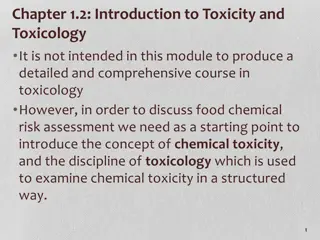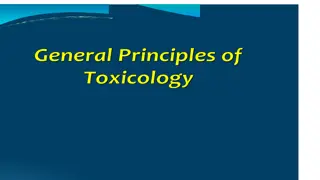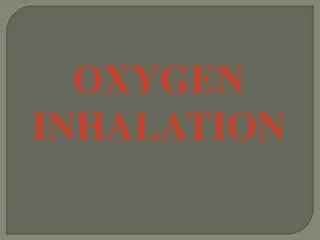Understanding Inhalation Anaesthetics in Veterinary Pharmacology & Toxicology
Explore the world of inhalation anaesthetics in veterinary medicine, from the concept of MAC to the classification of gaseous and volatile agents. Learn about blood/gas and oil/gas partition coefficients, along with the properties of popular volatile anaesthetics like Ether, Halothane, and Methoxyflurane.
Download Presentation

Please find below an Image/Link to download the presentation.
The content on the website is provided AS IS for your information and personal use only. It may not be sold, licensed, or shared on other websites without obtaining consent from the author. Download presentation by click this link. If you encounter any issues during the download, it is possible that the publisher has removed the file from their server.
E N D
Presentation Transcript
Inhalant Anaesthetics Dr.Kumari Anjana Assistant Professor Deptt. of Veterinary Pharmacology & Toxicology Bihar Veterinary College, Bihar Animal Sciences University, Patna
INHALATIONAL ANAESTHETICS MAC: MAC is the minimum alveolar concentration; the lowest concentration of the inhalant anesthetic in pulmonary alveoli in producing immobility due to surgical incision in 50% of the individuals. It is the measure of potency of inhalation anaesthetics. The anaesthetic potency of an inhaled anaesthetic is inversely related to MAC. Potency = 1/MAC; i.e. an agent having low anaesthetic potency will have a high MAC value and vice-versa.
INHALATIONAL ANAESTHETICS contd Classification of Inhalational Anaesthetics: Gaseous agents: Nitrous oxide and Cyclopropane. Volatile liquids: Methoxyflurane, Halothane, Ether, Chloroform, Enflurane, Isoflurane, Desflurane, Sevoflurane.
Blood: Gas Partition Coefficient: The blood/ gas solubility is a measure of the speed of anaesthetic induction, recovery and change of anaesthetic levels. Lower the blood/ gas partition coefficient, the more rapid the anaesthetic induction or rate of change of anaesthetic level in response to a stepwise change in anaesthetic delivery.
Oil: Gas Partition Coefficient: A measure of fat solubility, determines the potency of an anaesthetic and also influences the kinetics of its distribution in the body, the main effect being that high lipid solubility delays recovery from anaesthesia.
Volatile Anaesthetics Parameter Properties Ether Halothane Methoxyflurane Characteristic pungent odour. Decomposes upon exposure to sunlight. Butylated hydroxytoulene is added as preservative. 0.23 Slow induction (10 min) Stage II bypassed No change in heart rate or mild tachycardia. Adrenaline can induce cardiac arrhythmia. Characteristic oduour and sweetish taste. Oxidizes to peroxides (irritate resp. tract) upon exposure to moisture. Characteristic sweetish odour. Decomposes upon exposure to sunlight (0.10% thymol is added as preservative). 0.75-1.20. Induction 3-5 min Stage II bypassed Direct myocardial depression (reducing intracellutar Ca++). Sensitizes heart to catcholamines (arrhythmia) MAC (%) 3 Least potent. Slow induction All stages are seen Induction- release of adrenaline: increase in heart rate & BP. Stage III: Fall in BP and COP (depression of VM centre). Does not sensitize heart to catecholamines. CNS CVS
Respiration Initial stimulation followed by progressive depression. Increase bronchial secretion. Depression with increase in duration of anaethesia, may develop acidosis. Initial stimulation followed by progressive depression with increase in anaethesia. SK. Muscle relaxation Sig. effect. Dose of dTC to be reduced to one- third Prolonged lowers liver Not hepatotoxic Long oliguria/anuria due to ADH release Hypothermia Low to satisfactory relaxation. dTC can be used if needed. Adequate relaxation dTC can be used if needed. Liver anesthesia glycogen. Hepatotoxic like chloroform No significant effect Kidney duration: No significant effect No significant effect Body Malignant hyperthermia in pig and horse (persisten muscle contraction due release of Ca++ from sarcoplasmic reticulum) and hypothermia in others. Hypothermia Temperature
Foetus & Uterus No significant effect Reduce uterine contractions. Reduce uterine contractions Neutralizes oxytocin. Readily crosses placenta. No vomition during induction or recovery. Neutralizes oxytocin. Readily crosses placenta. Nauses & vomition common during induction or recovery Most potent. GIT Nauses & vomition common during induction recovery. Safest in small animals with proper premedication. or Merits Potent; used in small or large animals; rapid induction (3-5 min) & recovery (10-15 min): nonirritant, ready control of anaesthesia (low blood solubility), nonflammable & nonexplosive Can be used in small or large animals. Ready anaethesia. analgesia, relaxation. Cheap. control of Good muscle Excellent muscle relaxation and analgesia. Nonflammable. No needed. costly equipment is
Demerits Highly flammable. Difficult to use in hot climate. irritant to resp. tract. Delayed induction without proper premedication Resp. and cardiac depression and poor muscle relaxation and analgesia. Malignant hyperthermia in pig and horse. Easy control of anaesthesia not possible (high blood solubility). Recovery prolonged. Poor vaporization. Needs close circuit apparatus Noradrenalin or epinephrine without premedication Expensive (requires closed circuit apparatus) Aminoglycoside antibiotics (synergistic curariform effect), catecholamine s and Ca Channel blockers. CHF Used in small and large (horse) animals, mainly for maintenance (2-8 ml/45 kg/hr) of anaesthesia with NO2, after induction by ultra- short acting barbiturate. Contra- Aminoglycoside (synergistic curariform effect) antibiotics indications Uses Not used in human or vety, surgery. Used in small or large animal surgery for induction (3% MF+N2O(70%)+O2(27%) and maintenance (2-3%) Mainly use in lab animals for surgery or euthanasia
Enflurane A colorless, pungent, nonflammable volatile liquid, chemically related to methoxyflurane. The most frequently used potent anaesthetic in human surgery. It is classified as a convulsive anaesthetic (epilepsy like seizures; disscociative-cataleptic anaesthesia). Its MAC for horse is 2.12%. It causes CNS excitation in dogs causing muscular twitching (face, neck, limb and abdomen) if diazepam preanaethesia is not given. In comparison to halothane this does not sensitize heart to catecholamine s and has more depressant action on respiration and better muscle relaxation.
Isoflurane Though an isomer of enflurane does not cause CNS excitation. It is about one and half times more potent than enflurane MAC 1.3%. It provides satisfactory skeletal muscle relaxation (synergistic neuromuscular blockade with curariform agents).
Chloroform It is replaced by other safer anaesthetics, sometimes used for euthanasia. Its use is associated with risk of death of the animal during induction, prolonged anaesthesia and during post-anaesthetic period. During induction majority of deaths occur due to direct toxic effect on heart. During stage I the animal tries to avoid inhaling chloroform vapours by temporary breath- holding, which is followed by reflex deep breathing taking a high concentration of chloroform vapours into lungs, from there through pulmonary veins into the heart, causing ventricular fibrillation and/or cardiac arrest. Cardiac toxicity may be avoided by proper premedication (sedatives) and slow administration of chloroform. Prolonged surgical anaesthesia may cause respiratory failure due depression of medullary respiratory centre. exposure to air and light chloroform gets oxidized to phosgene gas (a marked lung irritant). Phosgene formation is prevented by adding ethyl alcohol @ 1 per cent.
Nitrous Oxide (N2O; Laughing gas) It is discovered by joseph Priestly (1772). It is a colorless nonirritating and nonflammable gas. It causes excitement, delirium and amnesia in humans, hence the name laughing gas. Has very low anaesthetic potency (MAC 188 (cat) 255 (dog)%) and hence must be combined with other inhalation anaesthetics (halothane or methoxyflurone). It has good analgesic, but poor muscle relaxant effects. To avoid hypoxia, it is used in combination with oxygen (nitrous oxide 70% oxygen 25%) and other inhalation anaesthetic (0.2 2%).
Cyclopropane Colorless gas with a characteristic odour. It can be used in small animal surgery of short duration after diluting with oxygen (4 times) through a closed circuit system. Morphine premedication and catechloamines are contraindicated due to marked respiratory depression and cardiac arrhythmic respectively. It causes adequate skeletal muscle relaxation. It forms flammable mixture with air.
